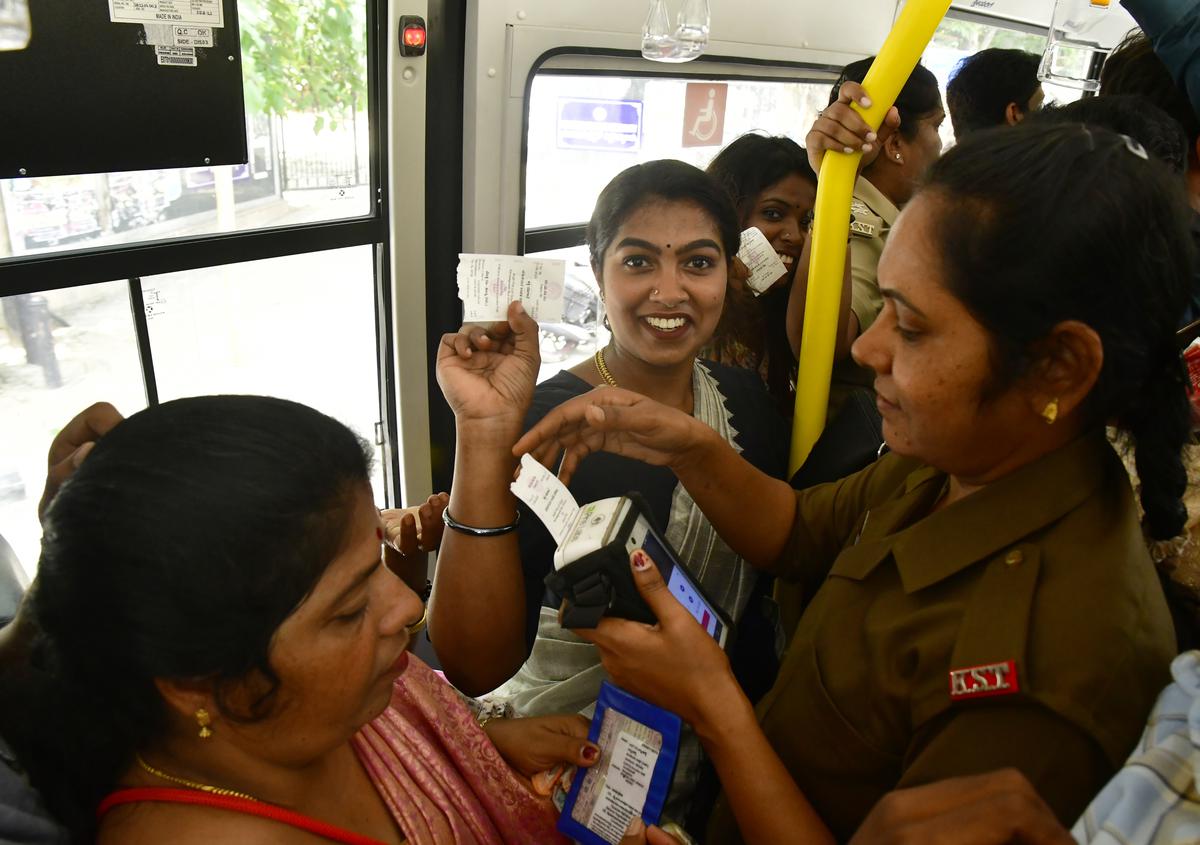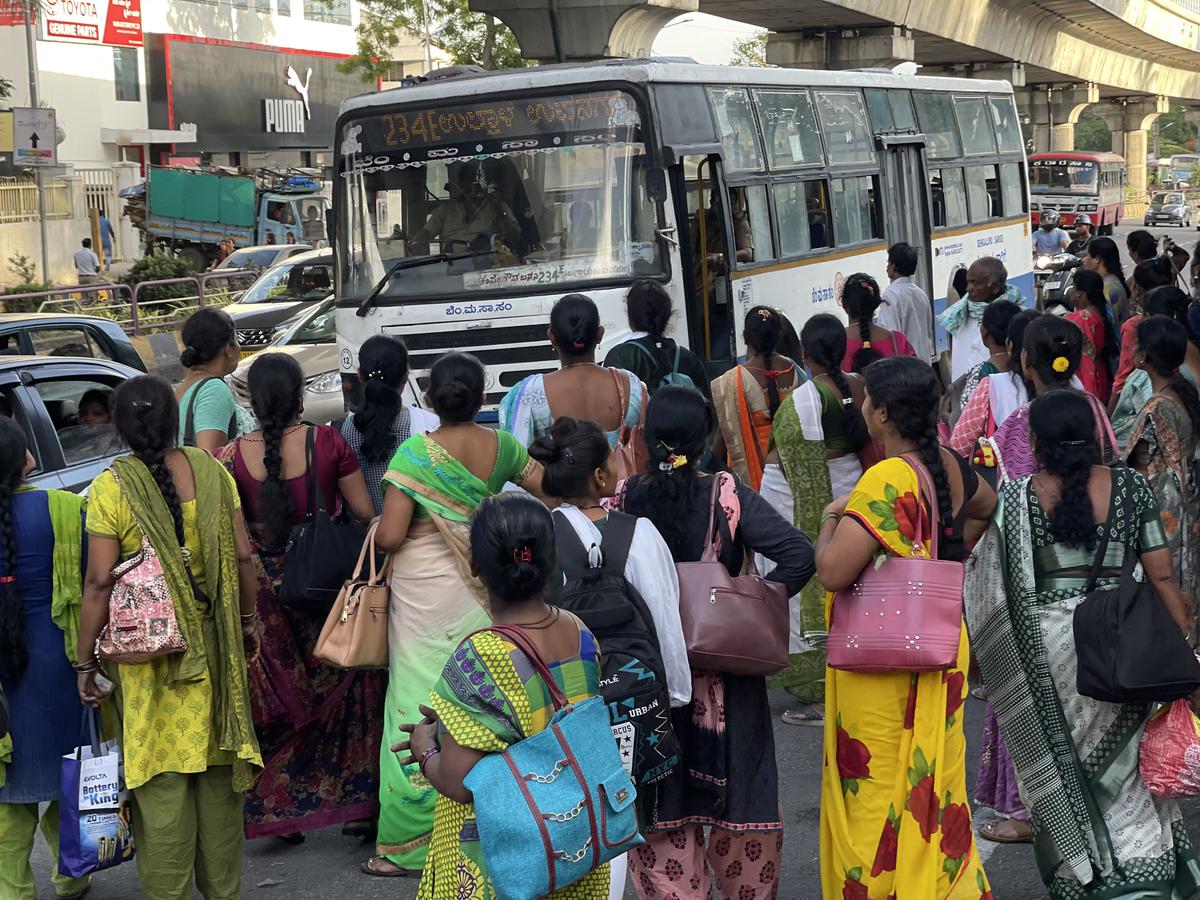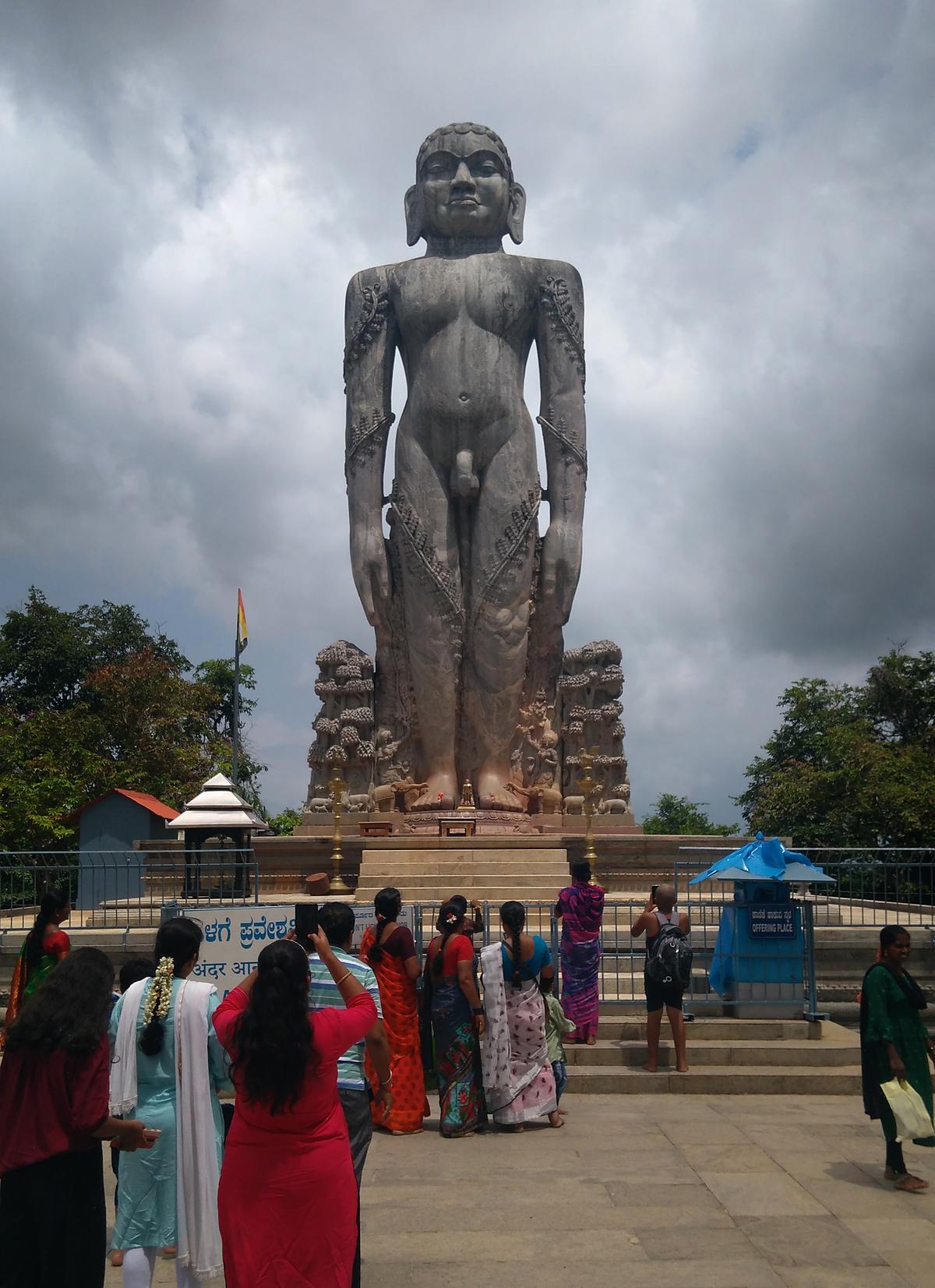Free ride, free spirit: What Shakti scheme means to women in Karnataka
Clutching a copy of her Aadhaar card, Parvathamma was waiting for the conductor to issue her a free ticket on a Karnataka State Road Transport Corporation (KSRTC) bus in Shivamogga town in south Karnataka. She was travelling to Holalkere in Chitradurga district in central Karnataka.
“The journey would have cost me ₹70. Now I travel free,” said a visibly elated Parvathamma, in her 70s. With the money saved, “I spend on some betel leaves and snacks for the journey.”
At Bengaluru, Kausar and her group of 10 women, all from the same family, were at the KSRTC bus terminal in Majestic, waiting for their changeover bus to Mysuru. They had just returned from their first women-only trip to Murugamalla Dargah in Chintamani in Kolar district. She said the group saved ₹2,000-₹3,000 on the trip as they did not have to spend on tickets. They plan to go on more such trips.
Shakti, which was introduced by the Siddaramaiah-led Congress government as part of the party’s election promise, has proved to be very popular among women.
| Photo Credit:
N. Ravichandran
Over 78 crore and counting
Over 78 crore women passengers have availed themselves of the Siddaramaiah-led government’s flagship Shakti scheme, which provides free bus travel to women of Karnataka domicile on non-luxury buses of the State-run Road Transport Corporation. Four months since the implementation of the scheme, beneficiaries talk about their experiences.
Kamalabai, a 50-year-old Lambani woman from Sonth Puru Tanda, travels around 50 km daily to reach Kalaburagi in the Kalyana Karnataka region in search of work, just like hundreds of people from her hamlet. Since there is no direct bus facility, she takes a shared three-wheeler to reach Kamalapur, which is around 16 km from her settlement, paying ₹30. From Kamalapur, she takes a public transport bus operated by the State-owned Kalyana Karnataka Road Transport Corporation (KKRTC) to reach Kalaburagi, which would have cost her ₹30 more if not for Shakti.
“I travel daily. I normally get work for 20 days in a month. Before the introduction of the Shakti scheme, I spent ₹120 daily on travel. It is a big amount for a person who gets just ₹450 daily. It was worse when I didn’t get work on a particular day as I had to spend the travel expenses from my pocket,” said Kamalabai. She said the number of people who travelled searching for work has increased since the introduction of Shakti.

A conductor issuing “free tickets” to women on a BMTC bus in Bengaluru.
| Photo Credit:
K. Murali Kumar
One scheme, different meanings
The scheme means different things to different women. For the majority, Shakti is a means to save small amounts of money; for some, it is a gateway to travel and exploration across the State; for others, it is an expression of freedom. However, a small number are sceptical.
Sitting on a bus bound for the Davangere district from Bengaluru with her husband was Shwetha, a middle-aged woman. “I do not travel much except for a monthly trip to Bengaluru,” she said. She saved around ₹120 on her ticket. “The money I save here I spend on my husband’s medicines,” Shwetha said.
Even in the State capital, women, especially on the outskirts, who used to find it difficult to travel to the central parts of the city without spending hundreds of rupees, can now take these trips whenever they want. Neelamma, a domestic worker from Nagenahalli near Doddaballapur Road, spoke of how a few women in her neighbourhood have formed a festival shopping group.
“Before festivals, we catch a Bangalore Metropolitan Transport Corporation (BMTC) bus, which directly goes to K.R. Market. We buy flowers and fruits from there at a cheaper price. We were not doing that earlier as the money we saved during the purchases would be spent on travel. Also, we do not have to depend on our husbands to go shopping now,” Neelamma said.
Amidst the rising costs of all other goods and commodities, some women feel that the savings from Shakti barely amount to anything. Gowri, from Bengaluru, was travelling to Chitradurga to her mother’s house. She said she saved around ₹600 on a round trip. “It is not a big amount if you consider the current prices of everything in the market. I do not feel I have saved any money as I do not travel regularly.”
Marakka, who hails from a remote village in Chitradurga district, shared a similar opinion. She had been to Murudeshwara in Uttara Kannada along with her family to work at a road construction site. “We keep travelling to Challakere often on this route. As travel is part of our lives, we keep some of our earnings aside. The amount saved due to a free ticket under the Shakti scheme is not a big thing,“ she said. Instead of free travel, the government should have given us more free grain. “Considering the prevailing prices of essential commodities like cooking oil, rice, and vegetables, it is difficult to manage expenses,” she said.

A large number of women who work in the garment industry wait to board buses at the Muthurayanagar bus stop in Bengaluru.
| Photo Credit:
K. Murali Kumar
Connectivity first, free tickets next
However, women in regions poorly served by KSRTC buses are disappointed. In districts like Shivamogga and Dakshina Kannada, private buses offer far better connectivity compared to government buses, rendering Shakti barely of consequence.
In Coastal Karnataka, KSRTC buses operate only on highways while other government-run buses only provide skeletal services, passengers said. Synthia Fernandes, who taught at a pre-university college at Modankapu, in Dakshina Kannada, said she travelled daily between Siddakatte (on B.C. road-Moodbidri road) and Modankapu in private buses by spending ₹60 as travel fare a day. Had there been government bus services, she could have saved the amount. At the other end of the State, in Lambani tandas in Kalaburagi, too, women flag the issue of an inadequate network of government-run buses.
When Transport Minister of Karnataka, Ramalinga Reddy, was asked about this problem, he pointed out that private buses in some places have been operational for a long time, leading to a monopoly. “Women in such regions and private bus operators have been asking us to extend the scheme to those buses as well, but that is a decision for the Chief Minister to make,” Reddy said.
Need for more buses
Even in areas served well by public transport buses, the fleet strength has to be increased to cope with the large number of women who are now travelling. Shashikala was waiting at the Ramanagara bus stop with her daughter in the hope of finding a less crowded bus to get back to Bengaluru in the evening. She had to wait for another 45 minutes for the crowd to clear and get a bus that had vacant seats. “I am not very happy with Shakti. All the government buses are crowded, especially on weekends. It’s difficult to travel especially with children,” she remarked.
Acknowledging the problem, the Transport Minister said there is a shortfall of around 11,000 buses. “While we need 35,000 buses for our population, we only have 24,000 now, just as it was 10 years ago. However, in the next three to four months, 5,000 new buses will be added. Also, 6,800 members have been cleared for recruitment in the first phase,” he said.
Reddy, however, argued that the scheme is a success going by the sheer number of women who are now travelling — to their favourite tourist spots, temples or homes of their relatives and friends — making use of the Shakti scheme.

Devotees at the Bahubali statue in Dharmastala. There has been an increase in the number of women tourists after the introduction of the Shakti scheme in Karnataka.
| Photo Credit:
K. Bhagya Prakash
Cost of free tickets
A section of women said that they enjoyed the benefits of Shakti, but were worried about the toll the scheme would take on the exchequer. Savithramma, an elderly flower seller who travels from Mysuru Road Satellite Bus Stand in Bengaluru to M.M. Hills in Mysuru district, said, “I am happy that this scheme has provided an opportunity for poor women like me to travel freely. However, I am also sad as this will burden the government hugely. Even the government exchequer is like our household budget, isn’t it?”
Kalpana, part of a 12-member group travelling to the tourist town of Halebidu in Hassan from Shivamogga, shared the same concern. “It is beneficial to me as a passenger. But I am worried if it will make the State financially weak.”
According to the data provided by the Transport Department, the cost of the tickets issued to more than 78 crore women under Shakti is over ₹1,800 crore. Compared to the ticket value of June (between June 11 and June 30), which was ₹248 crore (over 10 crore women passengers), it has increased by around eight times. The State Budget presented by Siddaramaiah earmarked ₹2,800 crore for the implementation of this scheme this financial year.
Not all believe that such welfare measures are a burden on the exchequer. Shaheen Shasa from Bus Pryanikara Vedike, a forum of bus commuters, pointed out that ₹2,800 crore is a small percentage when the State’s entire Budget (₹3,27,747 crore) is considered. She said providing free travel to women is similar to setting up public schools or public health centres, as it means the welfare of a larger group of people.
“It is not a tax burden. It is basically our tax money and a question of how the government prioritises the expenditure. Transport infrastructure is essential as it provides opportunities for education, health, and even political participation. The scheme enables a better lifestyle, and hence, it should be considered a positive investment,” Shasa said.
For all the latest Life Style News Click Here
For the latest news and updates, follow us on Google News.
